

Indo-European languages. The Indo-European languages are a family of several hundred related languages and dialects.
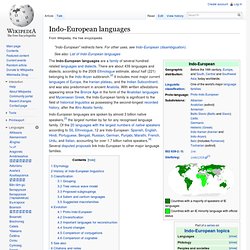
There are about 439 languages and dialects, according to the 2009 Ethnologue estimate, about half (221) belonging to the Indo-Aryan subbranch.[2] It includes most major current languages of Europe, the Iranian plateau, and the Indian Subcontinent, and was also predominant in ancient Anatolia. With written attestations appearing since the Bronze Age in the form of the Anatolian languages and Mycenaean Greek, the Indo-European family is significant to the field of historical linguistics as possessing the second-longest recorded history, after the Afro-Asiatic family. Indo-European languages are spoken by almost 3 billion native speakers,[3] the largest number by far for any recognised language family. Etymology[edit] History of Indo-European linguistics[edit] Franz Bopp, pioneer in the field of comparative linguistic studies. Gaston Coeurdoux and others made observations of the same type.
Germanic languages. Italic languages. Indo-Aryan languages. Anatolian languages. German language. German (Deutsch [ˈdɔʏtʃ]) is a West Germanic language that derives most of its vocabulary from the Germanic branch of the Indo-European language family.[9] Several German words are derived from Latin and Greek, and fewer are borrowed from French and English.
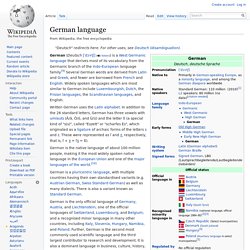
Widely spoken languages which are most similar to German include Luxembourgish, Dutch, the Frisian languages, the Scandinavian languages, and English. German is the native language of about 100 million people, making it the most widely spoken native language in the European Union and one of the major languages of the world.[10] German is a pluricentric language, with multiple countries having their own standardised variants (e.g. Austrian German, Swiss Standard German) as well as many dialects. There is also a variant known as Standard German. Anatolian languages. Area where the 2nd millennium BC Luwian language was spoken.
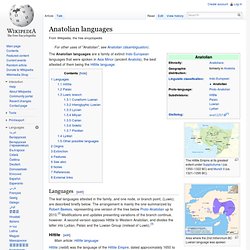
Hellenic languages. Albanian language. Albanian (shqip [ʃcip] or gjuha shqipe [ˈɟuha ˈʃcipɛ], meaning Albanian language) is an Indo-European language spoken by approximately 7.4 million people, primarily in Albania, Kosovo, the Republic of Macedonia and Greece, but also in other areas of the Balkans in which there is an Albanian population, including Montenegro and Serbia (Presevo Valley).

Centuries-old communities speaking Albanian-based dialects can be found scattered in Greece, southern Italy,[3] Sicily, and Ukraine.[4] As a result of a modern diaspora, there are also Albanian speakers elsewhere in those countries and in other parts of the world, including Scandinavia, Switzerland, Germany, Austria and Hungary, United Kingdom, Turkey, Australia, New Zealand, Netherlands, Singapore, Brazil, Canada, and the United States. The earliest written document that mentions the Albanian language is a late-13th-century crime report from Dubrovnik. Gheg Albanian. Gheg is spoken in Northern Albania, Kosovo[a], northwestern Republic of Macedonia, southern Montenegro and Serbia.

It is also spoken in parts of Sicily and southern Italy. [citation needed] There are still some authors who write in Gheg. Gheg does not have any official status as a written language in any country. Publications in Kosovo and Macedonia are in standard Albanian, which is based on Tosk. Dialects[edit] Gheg has several dialects, notably: Tosk Albanian. Armenian language. Western Armenian. Western Armenian (Armenian: արեւմտահայերէն, formerly referred to as թրքահայերէն, "Turkish-Armenian")[2] is one of the two standardized forms of modern Armenian, the other being Eastern Armenian.
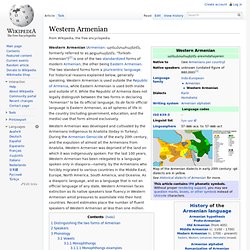
The two standard forms form a pluricentric language. For historical reasons explained below, generally speaking, Western Armenian is used outside the Republic of Armenia, while Eastern Armenian is used both inside and outside of it. While the Republic of Armenia does not legally distinguish between the two forms in declaring "Armenian" to be its official language, its de facto official language is Eastern Armenian, as all spheres of life in the country (including government, education, and the media) use that form almost exclusively. Western Armenian was developed and cultivated by the Armenians indigenous to Anatolia (today in Turkey). Eastern Armenian. Eastern Armenian (Armenian: արևելահայերեն arevelahayeren) is one of the two standardized forms of modern Armenian (an Indo-European language), the other being Western Armenian.
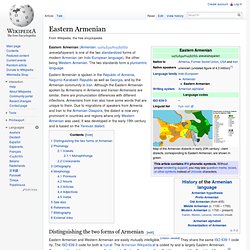
The two standards form a pluricentric language. Distinguishing the two forms of Armenian[edit] Eastern Armenian and Western Armenian are easily mutually intelligible. [citation needed] They share the same ISO 639-1 code hy. The ISO 639-3 code for both is hye. Phonology[edit] Vowels[edit] Monophthongs[edit] Eastern Armenian has six monophthong vowel sounds. Consonants[edit] This is the Eastern Armenian Consonantal System using symbols from the International Phonetic Alphabet (IPA), followed by the corresponding Armenian letter in parentheses. Notes The phonology of Eastern Armenian preserves the Classical Armenian three-way distinction in stops and affricates: one voiced, one voiceless and one aspirated.